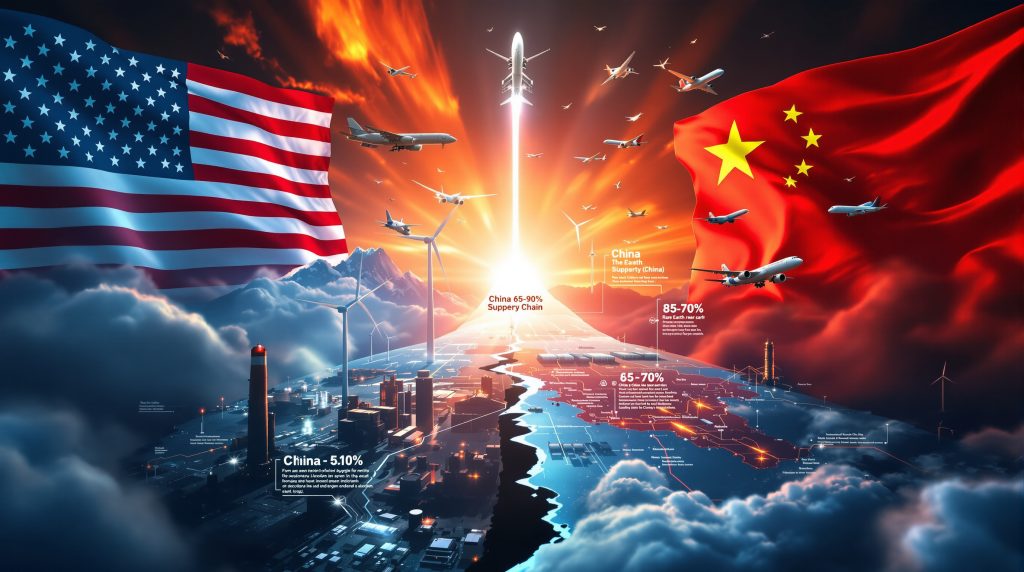US-China Rare Earth Tensions: How Flight Restrictions Could Impact Global Supply Chains
The recent call by US Representative John Moolenaar to restrict Chinese airline landing rights represents a significant escalation in the ongoing rare earth materials dispute between the United States and China. This Republican lawmaker, who chairs a House committee on China, has proposed these aviation restrictions as leverage to counter China's tightening control over critical minerals energy security. Moolenaar's proposal specifically aims to pressure Beijing to restore full access to rare earth materials and magnets by targeting a strategic Chinese economic sector.
The congressman's statement emphasizes that these measures would "send a clear message to Beijing that it cannot choke off critical supplies to our defense industries without consequences to its own strategic sectors."
The Strategic Value of Rare Earth Elements in Global Security
Rare earth elements play a crucial role in modern defense systems, renewable energy technologies, and consumer electronics. These materials are essential components in everything from precision-guided missiles and radar systems to wind turbines and electric vehicle motors.
The strategic importance of these elements has grown substantially as:
- Military applications require specific rare earth elements for guidance systems, radar, and communications equipment
- Clean energy technologies depend heavily on rare earth magnets for efficiency and performance
- Consumer electronics manufacturers rely on these materials for miniaturization and functionality
- Advanced manufacturing processes incorporate rare earth elements in various precision tools
This concentration of critical applications makes rare earth supply chains a matter of national security for many countries, particularly the United States, which has recently moved to develop Australia's strategic reserve as an alternative source.
How Did China Gain Control Over Global Rare Earth Supplies?
China's Dominance in the Rare Earth Supply Chain
China has systematically developed its rare earth industry over decades, establishing dominance across the entire supply chain:
| Supply Chain Stage | China's Global Share (2025) | Strategic Significance |
|---|---|---|
| Mining Production | ~58% | Controls raw material access |
| Processing Capacity | ~85% | Bottleneck for refined materials |
| Magnet Manufacturing | ~90% | Critical for high-performance applications |
| End-product Integration | Significant | Leverage over finished goods |
This comprehensive control allows China to exert influence over global markets through export policies, creating vulnerability for countries dependent on these materials. The impact of this dominance has been particularly evident in the ongoing US–China trade war impact on various industries.
Historical Development of China's Rare Earth Strategy
China's dominance didn't happen overnight. The country implemented a long-term strategy that included:
-
Identifying rare earth elements as strategic resources in the 1980s
-
Investing heavily in mining technology and processing capabilities
-
Implementing favorable regulatory policies to support industry growth
-
Accepting environmental impacts that other nations avoided
-
Strategically acquiring foreign rare earth assets and technology
-
Developing domestic expertise in advanced applications
By 2025, this strategy has positioned China as the gatekeeper for materials essential to advanced technology and defense systems worldwide.
What Are the Recent Export Controls That Triggered This Dispute?
China's 2025 Rare Earth Export Restrictions
In 2025, China implemented strict export controls on seven critical medium and heavy rare earth elements:
- Samarium
- Gadolinium
- Terbium
- Dysprosium
- Lutetium
- Scandium
- Yttrium
These export controls require Chinese companies to obtain special licenses before shipping these materials internationally, effectively creating a mechanism to restrict Chinese flights over rare earths and other strategic commodities at will.
Impact on Global Supply Chains
The immediate effects of these export controls include:
- Price volatility in global rare earth markets
- Supply uncertainty for manufacturers reliant on these materials
- Accelerated efforts to develop alternative supply chains
- Diplomatic tensions between China and rare earth-dependent nations
- Strategic reconsideration of critical mineral policies in Western countries
For US defense contractors, these restrictions create particular challenges as many systems rely on Chinese-sourced materials that now face uncertain availability.
How Would Airline Restrictions Work as a Counter-Measure?
The Proposed Aviation Restrictions
Representative Moolenaar's proposal involves:
- Restricting or suspending Chinese airline landing rights in the United States
- Reviewing export control policies for commercial aircraft sales to China
- Potentially limiting parts and maintenance services for Chinese commercial aviation
These measures target China's aviation sector, which relies heavily on international connectivity and Western aerospace technology. The approach bears similarities to Trump's critical minerals order which sought to secure American supply chains.
Strategic Rationale Behind Aviation Restrictions
The aviation sector represents a strategic vulnerability for China for several reasons:
-
Chinese airlines depend on international routes for revenue and growth
-
The country's commercial aviation fleet still relies significantly on Western aircraft
-
Maintenance and parts supply chains involve international cooperation
-
Aviation represents a high-profile sector with economic and prestige implications
By targeting this sector, US policymakers aim to create leverage comparable to China's control over rare earth supplies.
Why Are Rare Earth Elements So Critical to National Security?
Defense Applications of Rare Earth Elements
Modern defense systems incorporate rare earth elements in numerous critical applications:
| Defense System | Rare Earth Elements Used | Critical Function |
|---|---|---|
| Precision-guided munitions | Samarium, neodymium | Guidance systems |
| Radar systems | Yttrium, terbium | Signal processing |
| Night vision equipment | Lanthanum, gadolinium | Optical properties |
| Communications systems | Various REEs | Signal amplification |
| Jet engines | Scandium, yttrium | Heat resistance |
| Naval propulsion | Dysprosium, terbium | High-performance motors |
The inability to source these materials could significantly impact military readiness and technological capabilities, which is why many countries are developing a comprehensive defence-critical materials strategy.
Critical Civilian Applications
Beyond defense, rare earth elements enable numerous technologies essential to modern economies:
- Electric vehicle motors require neodymium and dysprosium for efficiency
- Wind turbines use large quantities of rare earth magnets
- Medical imaging equipment depends on rare earth phosphors
- Fiber optic communications systems incorporate erbium and ytterbium
- Catalytic converters use cerium and lanthanum for emissions control
This dual-use nature makes rare earth supply chains both an economic and security concern.
What Are the Potential Consequences of Escalating Trade Restrictions?
Economic Impacts of Trade Restrictions
If implemented, these reciprocal restrictions could trigger cascading economic effects:
- Disruption to passenger and cargo air traffic between the world's two largest economies
- Supply chain complications for companies operating in both markets
- Potential price increases for consumer goods dependent on efficient air freight
- Financial impacts on airlines, airports, and tourism sectors in both countries
- Possible extension of restrictions to other economic sectors
These economic consequences would likely extend beyond the immediate targets to affect broader bilateral trade.
Geopolitical Implications
The proposed measures represent a significant escalation in US-China tensions with several potential implications:
-
Setting precedent for targeting civilian infrastructure in trade disputes
-
Risking further retaliatory measures from China in other sectors
-
Complicating diplomatic efforts to address broader bilateral issues
-
Potentially drawing other countries into choosing sides in the dispute
-
Creating uncertainty in global markets about future trade stability
This approach marks a departure from traditional trade remedies by directly targeting civilian transportation infrastructure, as China's grip on rare earths becomes a lethal weapon in the ongoing trade war.
How Are Other Countries Responding to Rare Earth Supply Challenges?
Diversification Strategies
Nations dependent on rare earth elements are pursuing multiple strategies to reduce vulnerability:
- Australia has expanded rare earth mining operations and processing capabilities
- European Union countries are developing strategic stockpiles and recycling programs
- Japan has invested in alternative technologies and overseas mining ventures
- Canada is accelerating exploration and development of domestic rare earth deposits
- India is working to revitalize its rare earth industry with government support
These efforts aim to create redundant supply chains that reduce dependence on Chinese sources.
International Cooperation Initiatives
Several international partnerships have emerged to address rare earth supply challenges:
-
US-Australia Critical Minerals Partnership focusing on exploration and processing
-
EU Raw Materials Alliance coordinating European efforts across the supply chain
-
Quad Critical and Emerging Technology Working Group involving US, Japan, Australia, and India
-
Various bilateral research initiatives on recycling and substitution technologies
-
Industry consortiums developing standards for responsible sourcing
These collaborative approaches recognize that no single country can easily replicate China's comprehensive rare earth ecosystem.
What Are the Long-Term Solutions to Rare Earth Supply Vulnerabilities?
Developing Alternative Supply Chains
Creating sustainable alternatives to Chinese rare earth supplies requires a multi-faceted approach:
- Reopening and expanding mines in countries with significant reserves
- Investing in processing technologies that reduce environmental impacts
- Developing workforce expertise in specialized metallurgy and processing
- Creating financial incentives for private sector investment in the industry
- Establishing regulatory frameworks that balance environmental protection with resource development
These efforts require significant time and investment to reach commercial scale.
Technological Alternatives
Research into reducing rare earth dependence includes:
-
Developing alternative materials with similar properties
-
Redesigning systems to use more abundant elements
-
Improving recycling technologies to recover rare earths from end-of-life products
-
Creating more efficient applications that require smaller quantities
-
Exploring synthetic substitutes for specific applications
While promising, many of these approaches remain years away from commercial viability at scale.
How Might This Dispute Evolve in the Near Future?
Potential Diplomatic Pathways
Several possible diplomatic scenarios could emerge:
- Bilateral negotiations leading to mutual de-escalation
- Involvement of international organizations like the WTO to mediate the dispute
- Industry-led solutions that bypass government restrictions
- Third-party mediation by countries with interests in both markets
- Gradual normalization as market forces create alternative supply chains
The complexity of global supply chains creates multiple potential paths to resolution.
Likely Industry Adaptations
Regardless of diplomatic outcomes, industries will adapt to the new reality:
- Accelerated investment in rare earth projects outside China
- Premium pricing for guaranteed supply chains
- Increased vertical integration by major technology companies
- Design changes to reduce dependence on restricted materials
- Development of secondary markets and recycling infrastructure
These adaptations will reshape global supply chains over time, potentially reducing the leverage that rare earth control currently provides.
FAQ: Understanding the Rare Earth Dispute
What exactly are rare earth elements?
Rare earth elements comprise 17 metallic elements on the periodic table, including the 15 lanthanides plus scandium and yttrium. Despite their name, most are relatively abundant in the Earth's crust but rarely occur in concentrated, economically viable deposits. Their unique electronic, magnetic, optical, and catalytic properties make them essential for numerous high-technology applications.
Why doesn't the US produce its own rare earth materials?
The US has significant rare earth reserves but faces several challenges in developing domestic production:
- Higher environmental standards increase production costs
- Complex permitting processes extend development timelines
- Limited domestic processing capacity creates a supply chain gap
- Specialized expertise has migrated to countries with active industries
- Economic competition from lower-cost producers has deterred investment
Recent initiatives aim to address these challenges, but developing a complete supply chain requires time and significant investment.
How would flight restrictions impact everyday consumers?
If implemented, flight restrictions could affect consumers in several ways:
- Potential price increases for products shipped by air between the US and China
- Possible travel disruptions for passengers using Chinese airlines
- Supply chain delays for time-sensitive goods
- Impacts on businesses with operations in both countries
- Potential spillover effects on broader economic relations
The severity of these impacts would depend on the scope and duration of any restrictions.
Are there viable alternatives to Chinese rare earth supplies?
While alternatives exist, they face significant challenges:
- Current non-Chinese production meets only a fraction of global demand
- Developing new mines typically takes 7-10 years from discovery to production
- Processing facilities require specialized expertise and significant capital
- Environmental concerns create regulatory hurdles in many countries
- Price competition from established Chinese producers challenges economic viability
Despite these challenges, recent supply concerns have accelerated development of alternative sources.
Ready to Spot the Next Major Mineral Discovery?
Stay ahead of market movements with instant alerts on significant ASX mineral discoveries, powered by Discovery Alert's proprietary Discovery IQ model. Explore our dedicated discoveries page to understand the exceptional returns from historic mineral discoveries and begin your 30-day free trial today.




